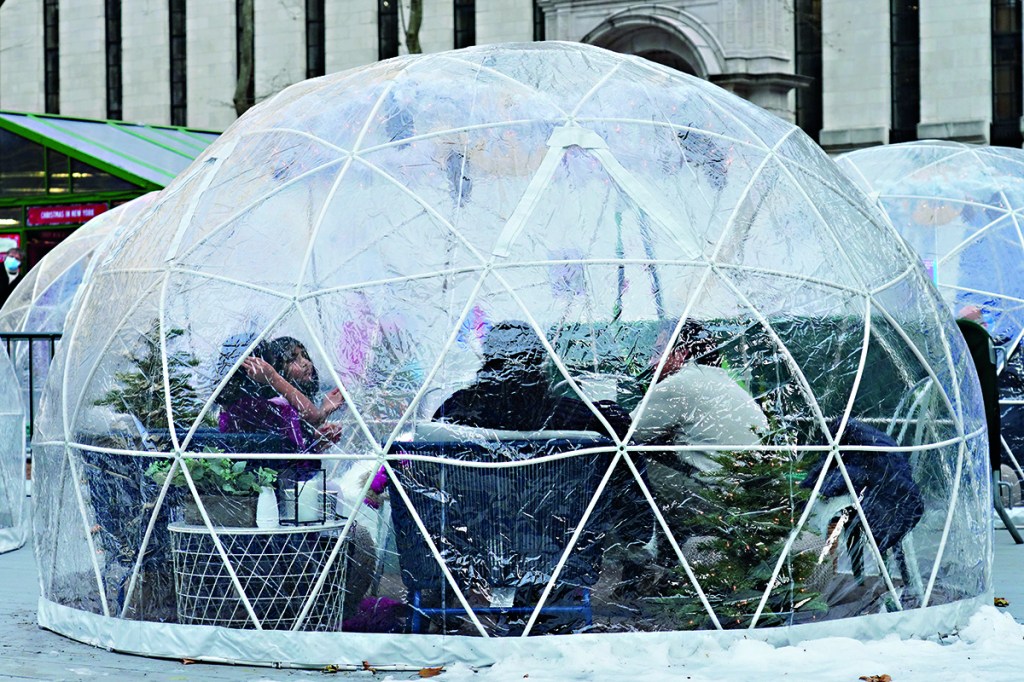One takes the chance, in writing about al fresco dining during winter, of getting pigeonholed as that guy who always goes on about how cold it is in Chicago. But if I’m to write about food and drink at this time of year, there’s no attractive alternative, unless you want to hear about my puttering in the kitchen making spaghetti, and how exciting is that?
With indoor restaurant dining forbidden due to the pandemic, the remaining choice is the outdoors — the ideal setting, in this challenging time, for the intrepid individual to demonstrate boldness without being a complete idiot about it, always a fine line.
The question is, how? Outdoor dining well into the fall had been a reasonably straightforward proposition, requiring merely that we maintained social distance from strangers to scatter the microbes. The onset of winter made matters more difficult. In some parts of the world, I gather, one can dine outside during winter equipped with nothing more formidable than a heavy coat with the collar turned up. Chicago isn’t one of those places. Planning is required.
There are three options, all improvisations prompted by the coronavirus. The first is patio seating — a nice way of saying the sidewalk with the addition of heat lamps. The second is a greenhouse, a small enclosure (capacity: four) of transparent panels kept warm by the body heat of the occupants. Finally there’s the igloo, a yurt-like arrangement of struts and clear plastic known in the 1960s as a geodesic dome, and associated in my mind with communes and consciousness-altering chemicals.
I initially favored igloos, which are often kitted out with couches, easy chairs and coffee tables. However, the cost of an igloo at the first place I checked, a Mexican-themed establishment called Barcocina, was $100 per person, which got you heat, food, bottomless drinks and a Bluetooth speaker. This seemed a bit stiff. So we went the patio route at The Publican (‘beer, pork & oysters’), which required only a $50 deposit plus a tolerance for risk.
I was apprehensive about paying to dine outside mid-winter. It’s one thing to spend 20 minutes having coffee on a sunny veranda at a ski resort. It’s another to park on a chair for two hours in the cold and dark. Mind you, the weather wasn’t especially trying by local standards. The previous day the temperature had reached 12°F, bracing even for Chicagoans, but on the day of our proposed expedition it was 27°F — basically sweater weather.
Even so, I took no chances, equipping myself with long underwear, four layers of clothing, a gaiter, ski gloves and knit hat, plus a pair of chemical shoe inserts warming the toes to 115°F by means of an exothermic reaction. The online photos suggested the outdoor space was, in fact, outdoors, but on arrival we found the proprietors, apparently sharing my anxiety about the cold, had enclosed the patio area in plastic sheeting, thereby converting the nominal outdoor venue into an indoor one. My wife balked, fearing the virus. I consulted with the front-of-house staff, who agreed to set up tables for our party on the sidewalk, rolling out three propane heaters in the hope of staving off hypothermia until we’d paid the bill.
I can testify with some astonishment that we had a delightful evening. A few family members joined my wife and me for the occasion. The meal was a savory mashup of pork belly, shrimp and barbecued carrots accompanied by mulled wine and hot toddies, consumed in entire comfort and enlivened by spirited conversation. Granted it was calm and dry, unlike, for example, now, when it’s windy and snowing. Life in Chicago teaches you to seize the moment.
The downside was that we burned around 600,000 BTUs of propane heating the street, indisputably a suboptimal use of resources. Hoping to improve on that score, the next day I cobbled together a more environmentally friendly homemade version using a scheme from a tech-minded friend. This consisted of a fire pit in the back yard surrounded by camp chairs, each wrapped in a pod-like enclosure of aluminized sheet foam and collectively looking like a conclave of space-age nuns. The idea was that the pods would capture the heat radiated by the fire, which was built using found materials (pine straw, twigs, leftover lumber) and started with a single match.
It worked…well, brilliantly would be overstating matters, since the pods captured not only heat but enough smoke to suffocate an elephant. However, once that problem had been brought under control by diligent poking of the fire, conditions became quite pleasant — more so once I brought out wine and cheese while my wife and daughter drank tea and roasted marshmallows. A modest achievement, you may say. But we felt, in that dark hour at the end of a grim year, that we had not merely endured but prevailed.
This article was originally published in The Spectator’s February 2021 US edition.

























